April 26, 2019.
I don't know what the deal is exactly, but it seems that last year was a year of trips with rain and snow, and this year - at least so far - it's all about the wind. It was so windy through the night that at some point I closed the door to the tent just to give us a bit of a reprieve from the insidious cold that kept pushing it's way under our comforters.
As the sun rose, so did the wind speeds - clouds zooming across the sky, Earth's natural kaleidoscope. I popped out for as long as I could muster - the wind whipping through the only long sleeves I'd brought on the trip, a light sweatshirt.
Always prepared, this one. 
In the end, we could only wait so long for the wind to die down - which it never did - before rousing ourselves out of bed to what was clearly going to be another beautiful day. We repeated our morning routine, splitting the breakfast and tent tasks, as the Playa seemingly blew away in front of us.
And that folks, is why there's so much sand at the Big Sand Gap that we'd visited the previous day.
As we wrapped up the last of our packing and I went to turn the temp on the fridge down - I normally turn it up at night to reduce battery usage when the truck isn't running - I noticed the display wasn't even on.
Uh oh.
Without a fridge, our food wouldn't last long - this could be the end of the trip if I couldn't get it figured out. Luckily, reasonably quickly, I found the leading candidate for what was causing the problem - the power cord had gotten stuck in the pull-out drawer slide and I could see where it'd been severely sliced.
Hoping nothing had been fried in the fridge itself, I checked the fuse on the cord - it was fine. Next, I checked for power at the distribution box in the bed - and there was nothing! Hopeful that it was just a fuse in the Bussman, I popped the hood and pulled a few fuses before finding one that was in fact fried.
Well, that was good news. Now the question was - did I have a spare?
It required a trip into the bowels of the OSK, but luckily I was able to pull out one 7.5A fuse and pop it into the circuit - disaster avoided, and a good reminder for me to stock a few more fuses in case something like this happens again. I temporarily patched up the cord as well and we were off the dusty Playa and on our way - the day's adventure off to an early start.
Still aired down from the day before, we made our way somewhat slowly south to the tiny town of Fields, OR. The only fuel for a hundred miles in any direction, we pulled in on fumes - the gas light in the truck having illuminated 27 miles earlier! Of course, we'd have been fine given the extra 10 gallons on the rear bumper, but it's always more convenient to just use the pump.
Fields Station is a well-known hangout in these parts, and even at 9:00am in the morning, it was was hopping - breakfast at the attached diner in full swing. As we fueled up at nearly $4/gallon, I even momentarily considered one of their famously delicious thick milkshakes - something @mrs.turbodb had referenced several times in the various books she'd brought on the area. Alas, it was early and we'd just eaten, so we passed as we got on our way - our next destination out a nearby powerline road: Borax Lake and it's hot springs.
As we neared the parking area, the sight of a couple vehicles was initially a bit disappointing - after all, we were in the middle of nowhere and were expecting to have the place to ourselves. As we got closer and eventually pulled along side, I think we ultimately felt a little better knowing that - at least - we were with family. 
The day getting sunnier (but still windy) by the minute, we set out from the truck towards Borax Lake. Fed by geothermal (hot) springs, this lake is 10-acres of 100°F water - perfect for a dip until you discover that it's got extremely high concentrations of not only borax, but also arsenic and lead! Still, though it's not something that we'd want to swim in, the Borax Lake chub fish - found only here - calls the lake home, having adapted to the warmer temps and high concentrations of toxins.
The geothermal activity of the site has resulted in the lake being uphill from the surrounding area - the lake essentially sitting on top of a hill of borax that has been pumped out of the ground, the lake itself contained within short borax walls. Accumulating at somewhere near 150 tons/year, it looks like there's snow on the ground, likely what drew the Rose Valley Borax mining company to the area in 1892. For 10 years, Chinese laborers gathered borax from the ground, mixed it in long boiling vats with water to purify it, and then transported it via mule team wagons to Winnemucca, NV.
As cool as all that was though, it wasn't why we were really here. We were really here because there are also a series of hot springs - and @mrs.turbodb loves hot springs. Extending for nearly a mile north of the lake, these springs aren't ones that you can take a dip in - they have the same arsenic and lead concentrations as the lake, and are 170°F to boot - but they are cool to look at, the water bubbling up out of the ground, sides of some springs dropping sharply into pools large enough to boil the unfortunate human or pet that might fall in.
Perhaps our favorite spring however was one that had an internal bridge - I assume, the minerals having accumulated over the years on some sort of existing rock structure.
We spend a good hour-and-a-half exploring the hot springs before deciding that it might be good to get a move on - the rest of our day uncertain from a mileage perspective. See, our plan - like the day before - was to explore some roads to the east of Alvord Playa. This time we'd be south instead of north, and we hoped to find a route to re-enter the Playa on the road we'd seen at Big Sand Gap.
Oh, and there was another set of hot springs that I was told we were visiting. Or at least strongly encouraged...which as we all know is really the same thing. 
So, we headed back to the truck.
From here, we followed the power line road east for many miles, winding our way up into the hills and ultimately onto the Columbia Plateau - spring clearly here, the landscape around us and uncanny green for the desert.
With nothing but rolling green hills around us, we made good time - our usual modus operandi of stop-every-couple-hundred-feet-for-photos, unnecessary. We did however spot several large cairns at the top of a few of the taller hills - markers perhaps for the desert trail. Or, left by aliens - instructing those that would come later that, "there's nothing here."
It was a bit before 1:00pm when the road we were on brought us to the edge of a corral - the land all BLM, but as is often the case, leased to ranchers for cattle grazing. There were no cattle here today, and as we scooted around the edge of the barb wire fence - our windows open to enjoy the cool breeze - the smell was amazing.
Yeah, I know that sounds weird. I mean, given how I set that up, you're probably thinking it smelled like cow shit. 
Get your head out of the gutter. It smelled like wildflowers. Little purple ones. They were everywhere. I promptly ran some over - to capture the moment.
And then we were off again, the other side of the corral joining up with what can only be described as a gravel super-highway in the middle of nowhere. We clearly need to get the engineers of this road to check out some of the highways in our neck of the woods - our pavement isn't as nice as these roads were.
Which meant that before long we'd reached Willow Creek Hot Springs, the location that had been suggested to me as one we might want to visit. I can't say this enough for the youngin's - those are code words for "or else."
As it turns out, Willow Creek Hot Springs was a very pleasant place. Reasonably un-populated, we had the slightly-developed but un-maintained 104°F spring to ourselves, and we enjoyed some amazing turkey sandwiches, chips, and fruit to boot.
Refreshed and refueled, we popped back onto the gravel for a few quick miles to the fork for our next destination - a faint road we'd traced from Big Sand Gap, back to the Whitehorse Ranch. We didn't know if it still really existed or was passable, but we were keen to find out.
The Whitehorse Ranch was started in 1869 by John S. Devine, the first permanent settler in what is now Harney County, OR. Often dressed in the flamboyant Spanish grandee style including silver-studded leather riding gear, he - perhaps obviously - rode a white horse as he managed the herd. It's changed hands several times since, and eventually partnered with the BLM to more sustainably manage the lands that were used for grazing.
And, after covering the first couple miles of road from the ranch, it was clear that we were definitely the first to travel the road this year, and perhaps the first in several years - it's tracks faint as it wound its way over the landscape.
Yes internet trolls, this is in fact the road.
While faint, we were seriously impressed by the reasonable condition of the track - my guess is that out here there isn't much that erodes a track once it's been created; there are no hillsides for rocks to slide down and onto the road; tree (roots) are nowhere to be found. As such, even with a faint track, it wasn't a rough ride and we were enjoying ourselves as we got closer and closer to our ultimate goal.
Our hope of course was that today would be different than yesterday - that we'd make it all the way back to Alvord Playa.
Well, today would be different than yesterday, but not in a good way.
50 miles into our day, and 4 miles from the Playa, there was water across the road. And by water, I mean a running creek that was more like a 4" deep lake, a quarter- to half-mile wide. I mean, it was a lot of water. Smartly, I stopped. I got out of the truck to take a closer look.
Now - it's not like we hadn't been through water up to this point - there'd been mud puddles, and even a 50-foot long, 4" deep creek crossing that we'd driven through. But this looked hairier - we couldn't see the other side. And, we were 8 miles from the Whitehorse Ranch at this point - so if we needed rescue, it was quite a hike away.
Smartly - again - we made the decision that it was just too risky. As a single truck, if we got stuck somewhere in the middle, we would be screwed. No trees to winch off of, no buddy to pull us out.
And then - un-smartly - I decided to pull forward just a few more feet. It was immediately evident that I'd screwed up - the entire driver side of the truck sinking 10" or so into the muck on the very edge of the creek-lake, the ground so saturated that it couldn't support any weight at all.
I threw it in 4Lo and reverse and attempted to back out...
Uh oh.
Wheel spin. And more sinking. I stopped. I knew - this could be bad. I looked over at @mrs.turbodb and said something along the lines of, "I'm going to need your help. Gather all the sage brush you can and start making a big pile."
With that, as fast as I could, I changed out of my running shoes and into my Muck boots and stepped out into the wet clay. I grabbed the shovel and started digging behind the front and rear wheels - each shovel full requiring all I could muster, the suction of the wet clay so great.
My heart was racing, the adrenaline coursing through my system.
A foot or two dug out behind the front and rear tires, I shoved as much dead sage as I could into the holes for traction and hoped it was enough - I knew I didn't have many chances to get this solved, the truck continuing to sink all the time, and each attempt to free the truck digging further down as the tires spun.
I started the engine. I was already in 4Lo, and I also engaged the front and rear lockers, hoping that the passenger tires which were on slightly firmer ground would be enough to pull the truck out.
Nope. More wheel spin. And more sinking. The front wheel was now up just above the center cap (which is still visible in the photos above) and the rear axle was just touching the water.
We were well past "shit" at this point on the cuss-o-meter, and the camera was long forgotten. 
To @mrs.turbodb, I said, "I'm going to give this one more try, and if it doesn't work, we're going to have to walk back. If I sink it any further, it's going to be hard to even pull it out with another truck. Keep collecting more sage."
And with that, I started digging more. I dug in 2' front of the tires, 8' in back of the tires, and all along the sides of the wheels, trying to free them from the suction of the mud as much as possible. and I shoved as much sage as I could down into these channels - hoping that if I could just get out of the holes and onto the brush, that it'd provide enough support to move the truck the requisite 15' back to firmer ground.
I climbed in, started the truck, and put it in reverse. The tires spun.  I put it in first and pulled forward slightly. Then, as the truck started sliding back, I threw it in reverse and gave it some juice. Mud was flying, the tires finding the smallest amount of traction - and then, against all odds, a bit more.
I put it in first and pulled forward slightly. Then, as the truck started sliding back, I threw it in reverse and gave it some juice. Mud was flying, the tires finding the smallest amount of traction - and then, against all odds, a bit more.
And what seemed like minutes, but was likely just a few seconds, more traction and the front of the truck lifted. We were out. My arms raised in victory I hopped out of the truck, the first words out of my mouth - "I've got so much adrenaline, I'm shaking."
The aftermath told the story - we'd narrowly avoided disaster.
And now we were happy to turn around. Never-mind that we'd driven 50 miles and had only a few to go. Never-mind that the same thing had happened yesterday. We wanted nothing more to do with this section of road at this time of year, and we high-tailed it back to the Whitehorse Ranch.
There, we ran into a couple of ranchers and inquired about the road to Big Sand Gap - "Does it go through? Is it passable?"
"It does go through, but it's not passable right now - way too wet up there." they said - "You don't want to get stuck in that, and we don't want to pull anyone out!"
Sure made us glad that we hadn't walked back to the ranch in need of a tug!
And with that, we found our way back to the Alvord Playa - it'd be our third and last night on the vast lake bed, and I think we were both looking forward to taking it easy.
Of course, by the time we arrived, @mrs.turbodb's adrenaline rush had crashed and she'd squeezed in a 45 minute nap. I also didn't really know what we'd do until it got dark, so we decided a nearby hike up Pike Creek was in order.
Along the western side of the Playa, Pike Creek was an old (failed) Uranium mine, and now offers stunning afternoon views of the Playa and some cool geology to boot. Plus, on the scale of boring-to-crazy, we'd had our fill of crazy for the day.
Perhaps predictably however, Pike Creek was raging - spring run-off from Steens mountain swelling it beyond its usually narrow channel, and our hike turned out to be more of a 30 minute stroll - not enough to make much of a dent in our evening.
So we did what any insane couple would do - we decided this would be the perfect time to see if we could find the west side of the road that we'd been stymied on the previous day. And if we could, then we wondered how close we could get to where the road had been so washed out that we had to turn around.
Had we even needed to turn around?!?
We raced along the eastern edge of the Playa, enjoying the perfectly flat ground and high speeds once again - it really never gets old. And - low-and-behold - nestled in the greasewood bushes, we found the end of the road!
Cognizant of the possibility of mud, we proceeded forward - slowly. And then, water! Perhaps understandably a bit cautious, I wasn't taking any chances - I got out of the truck and put on the boots. It was time to walk.
Could we have made it? Maybe. Did we consider trying? Nope.
The water seemed to extend for a good quarter mile or more, and it was clear to me that we'd have been in just as bad a position this time as we'd been just a few hours earlier. I was over that and @mrs.turbodb was cool without a second incident as well. So we once again turned around - the road and unfinished loose end that we will return to another time; and validation that we'd most definitely made the right call the day before.
Back out on the Playa, we found a secluded spot out in the open and I got to setting up camp while a dinner of lamb stew was prepped on the stove. As we ate our meal and gazed west towards Big Sand Gap, the last of the sun retreated over the land and up the hills.
It had been a long day. More eventful than we'd imagined when we'd set out; more than we'd really wanted. And yet, here we were, having survived it all, taking in the now purple sky over Steens Mountain.
I wouldn't have changed it for anything. And we still had another day - with some 100 miles of unscouted dirt roads between us and Hart Mountain National Antelope Wildlife Refuge - to go!
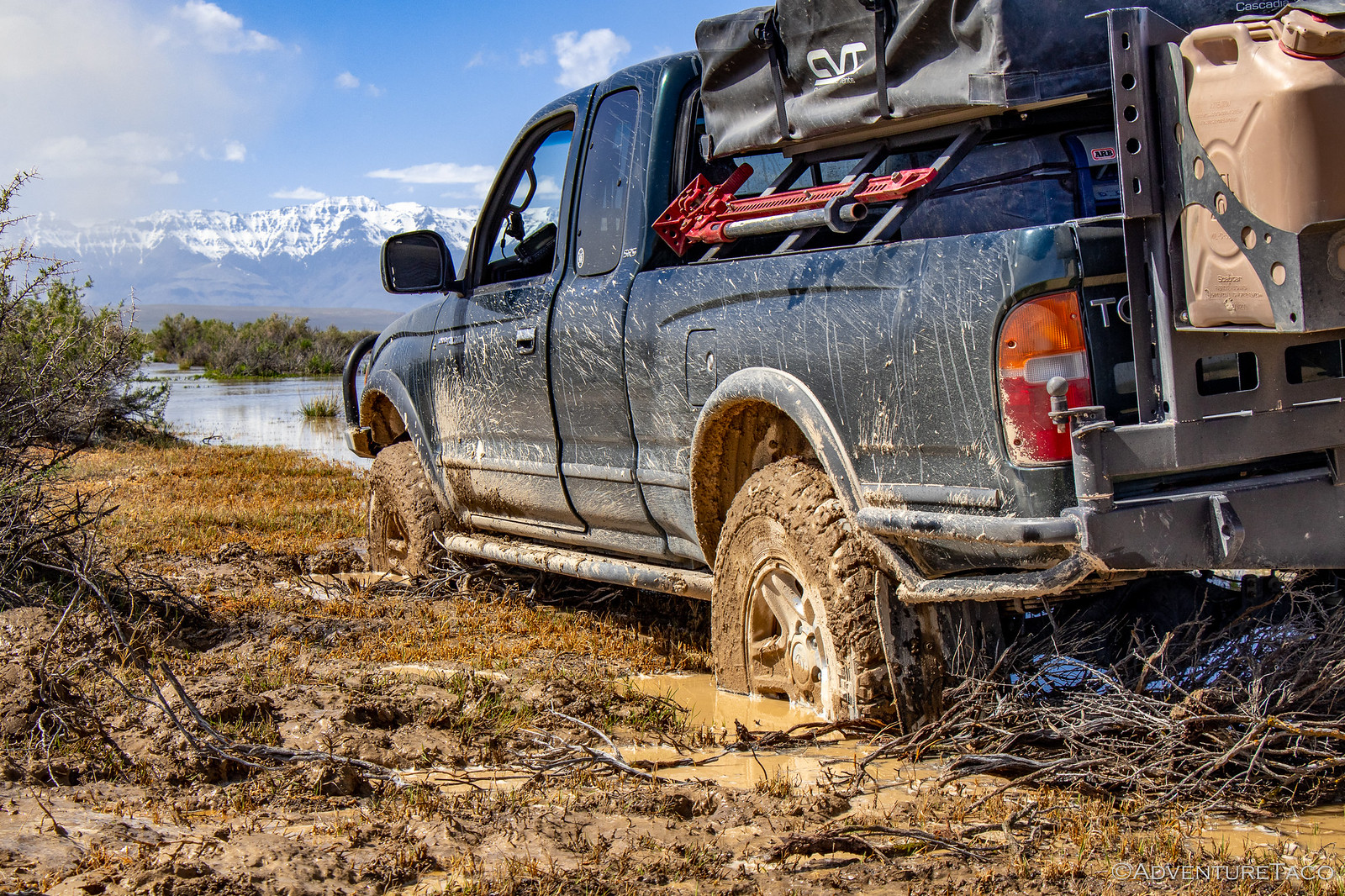

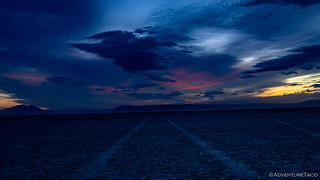

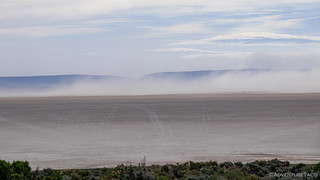

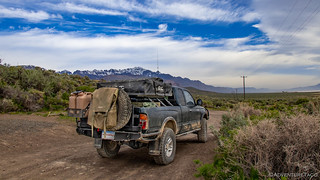
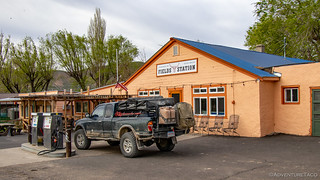




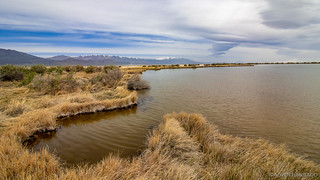





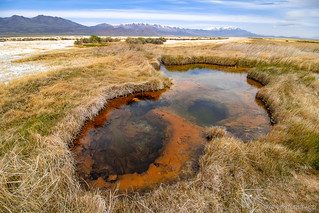





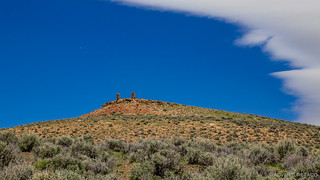


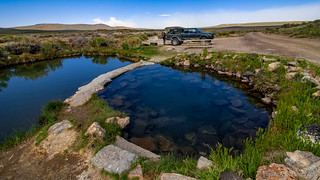





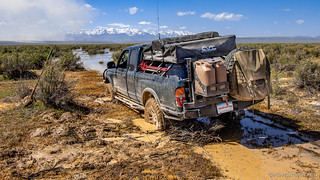
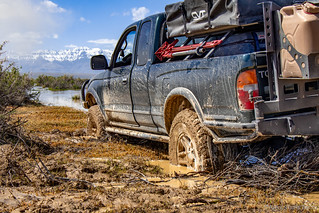







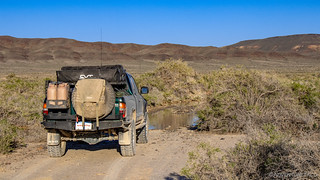
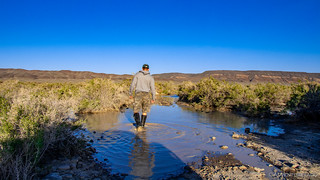



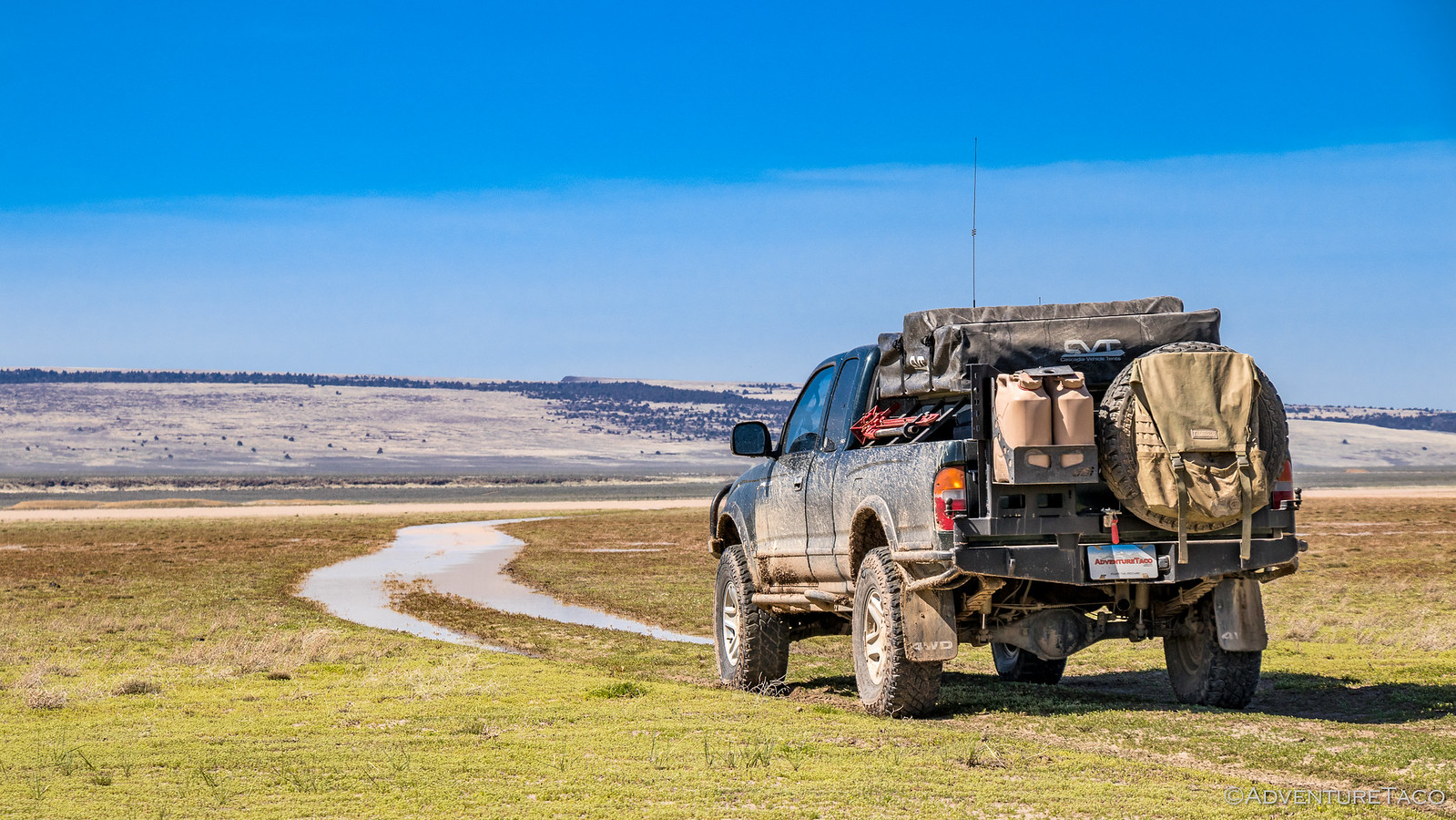

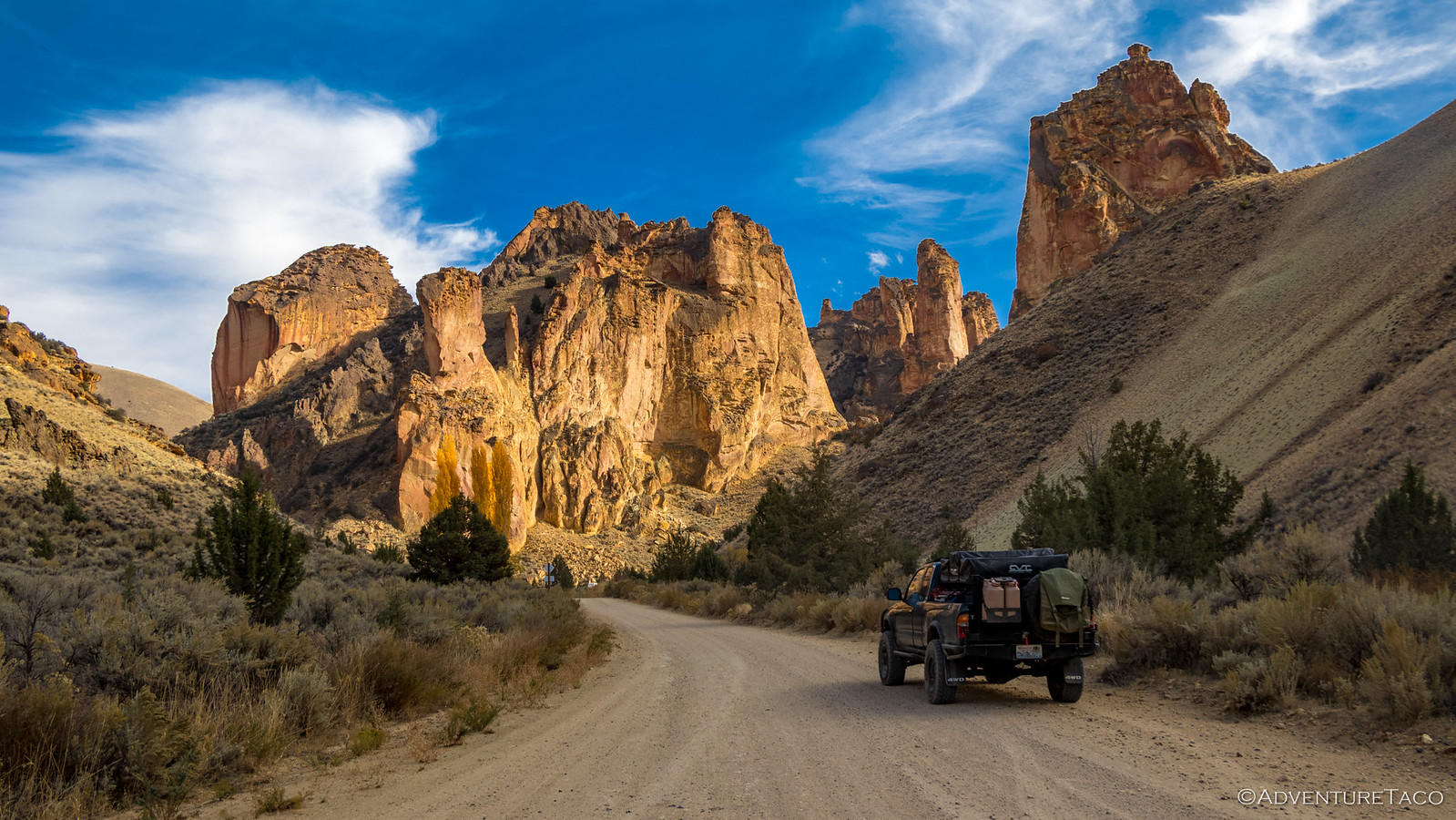
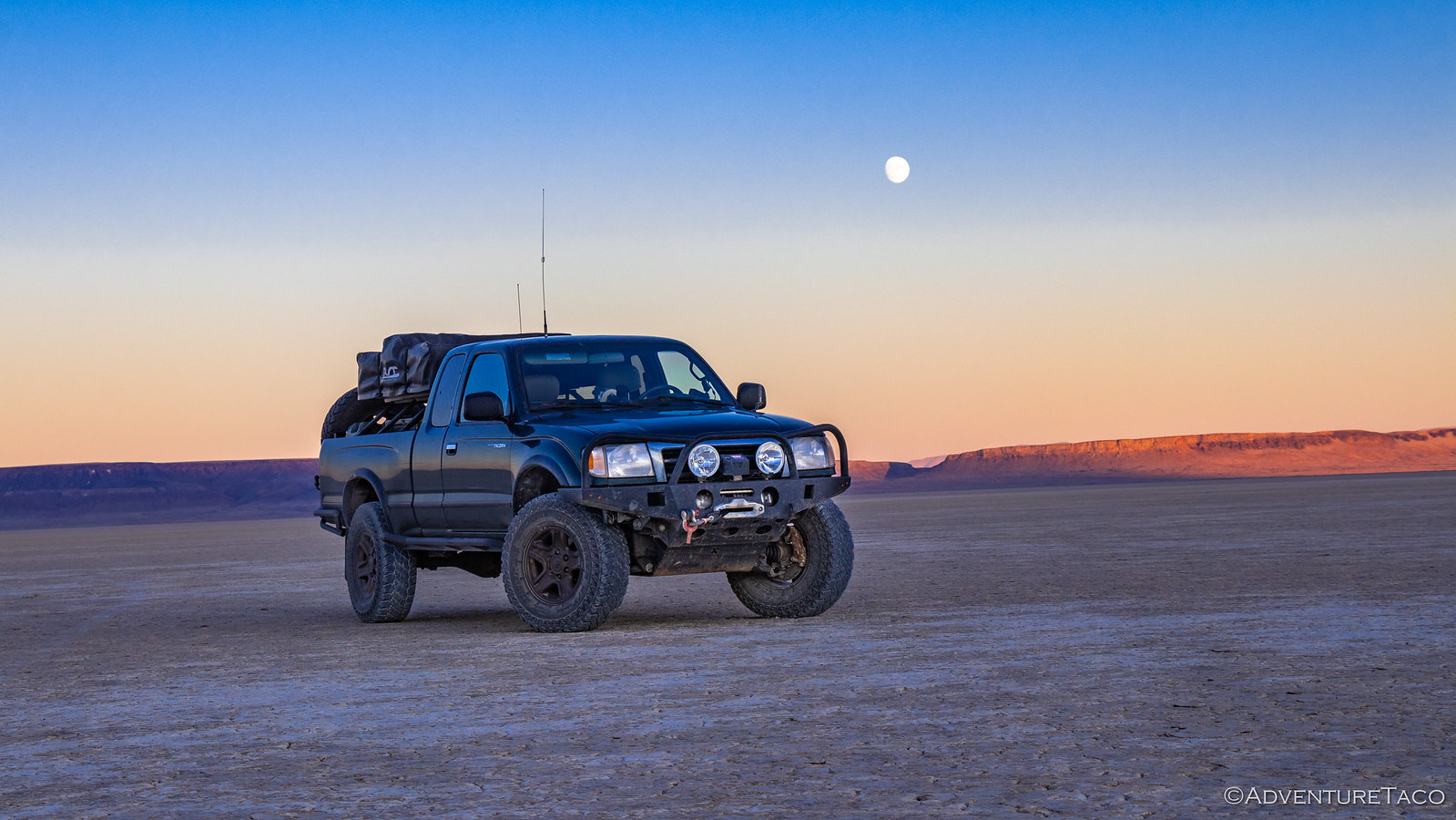
We woke up and the sky was overcast. Looking east, we couldn’t see the eastern rim: there was a huge dust storm reaching from the floor of the desert to the sky, creating a wall of gross. Fortunately, we were not in it. We could see, however, that others, both to the north and south, were not so lucky – of the five vehicles parked out on the playa, three of them were in the dust. We seemed to be in a pocket of calm. Given our plans for the day, hopefully the dust storm would be of little consequence.
After our usual breakfast and chores, we decided to take advantage of the wind and the dust cloud for pictures. [NOTE: This actually happened the day before. I misremembered it being the day after. Story is still the same, however.] This involved @turbodb asking me to drive the truck as fast as I could and then slow down before I reached the end of the playa. As usual when @turbodb asks me to drive the truck, I was both excited and terrified. The mantra of “don’t f’ up, don’t f’ up, don’t f’ up” was repeating in my head. Could I have heard that right? Accelerate to about 60, as fast as you can and then slow down before you hit the end of the playa. Ok, got it. And then it was my turn at the wheel. It felt like flying. Shifting is so much fun, and wow is the truck so much less speedy than my car. I did as I was told and I didn’t f’ up, but the pictures, I was told, were only meh. Oh well, I got to drive the truck!
With that done, we headed out of the playa and south – this time to Fields and the lone gas station. Following @turbodb’s usual protocol, we were nearly out of gas. Of course, we weren’t really out of gas given that we had two five gallon tanks in the back, but it would be nice to get away without using them. @turbodb seems to like the challenge of seeing how low he can go when it comes to gas, which has only burned him/us a few times and never in a place that it really mattered. As luck would have it, we made it to Fields and were able to fill up on their very expensive gas with mile(s) to spare at the gas/motel/grocery/café/lone-store-in-town.
With gas in the tank, we headed to our first destination: Borax Lake, another weird geological wonder. Borax lake is an aptly named lake of surprising size that rises above the surface of the lower Alvord area (it is south of the Alvord playa and lake). The lake is a hot spring that is 93 degrees year round and is the home to a small fish that lives no where else called (of course) the Borax Lake Chub. The water looks inviting until you find out that its’ arsenic levels are 29 higher than the allowable limit for humans. It is also surrounded by weird white borax dust. Back around the turn of the century, in one of our country’s less glorious moments, Chinese laborers were brought over to work at Borax lake where they would scrape up the borax off the surface of the ground and hot springs and boil it in big vats to collect the borax. Why they had to boil it wasn’t clear, but boiling nasty white powder in water to make more white powder all while in a hot desert sounds pretty awful. The giant vats the size of tanker trucks were on the trail just before the lake; to me, it felt like they were there as a reminder of their suffering. The borax was then shipped due south to awaiting trains in Winnemucca using twenty-mule teams, of course of course. Because of the lucrative borax, the lake and surrounding area was privately owned until The Nature Conservancy bought the property. It did seem like there were a lot of birds in the area, especially given that the lake is often the only unfrozen lake in the winter and a reliable water source in the summer.
However, for me, it was the trail beyond the lake where things started to get interesting. On the east side of the white borax powdered trail were two dozen or so hot spring pools of varying sizes and depths and colors. Some had big crystals at their edges threatening to close them up; others had internal bridges while others seemed to be twenty or more feet deep and only a few feet wide. We stared into their abysses and @turbodb hopped to the opposite side of them to get a better look, and I hoped he wouldn’t accidentally fall in. The hot springs seemed like they came out of nowhere. I tried to imagine what the first immigrants to the area must have thought when they came upon these – what a strange place this country is.
Then it was back in the truck, and off to over the hills and through the… sage brush. Our plan was to make our way east and then back onto the playa, this time through Big Sand Gap, our new “East Entrance.” The route began by following the telephone/power lines – not an uncommon road through places where there is nothing else because of course there is a road needed to maintain the line. We hoped our road would veer away soon enough. After cresting another hill and driving into unnamed valleys and around unnamed hills, we finally turned away from the powerline and entered our first gate.
All of the land we were driving on was BLM land (which I tend to think of as “our land” as in “This land was made for you and me…”) but there are fences and there is a lot of cattle, cow pies, and every now and then a gate, though never locked.
Crossing through the gate, we pressed on, until we came to a curious hill with two large stone cairns. We didn’t get close enough to see if they were graves or markers on the Oregon Desert Trail or just boundary markers. They were right on the edge of a bluff looking out toward the Alvord and Steens mountain. Whatever their purpose, they were in a beautiful spot.
We pressed on, and as the road deteriorated and didn’t seem as fun, we decided to take the dirt road slightly more travelled, through a few more gates and then down onto the gravel road to Willow Creek Hot Springs. This hot spring was a late addition to our plans, but I was eager to go there, not sure when we’d get a chance to go to this completely remote place again. And maybe it would be cool? The hot spring was in the middle of a BLM campground, and when we arrived, I noticed that there were no cattle grates or other fences around the campground or springs, which means that cows could just walk right up and poop in the pool – not the most sanitary conditions.
There were only two other vehicles at the campground/hotsprings – a small RV and a camper van which had been there for a while. After doing a bit of exploring, we realized that the hot springs next to the picnic table where we parked was in fact the hot spring. Sweet! It consisted of two adjoining pools – one hot, one cold – that was basically unmaintained and a pleasant temperature. After lunch, we decided to dip our feet into the 8’x8’ hot pool. It was at this point that I realized just how sunburned the backs of my legs were, likely from this morning’s walk around Borax lake under overcast skies. Not long after, the well-tanned owner of the camper van decided to walk by and his pup say hello, and then we left, back on our mission.
Our plan was to go as far east as White Horse Ranch, a prominent enough landmark that it is on most maps, likely because it is the only landmark. At one time, the ranch owned the 50,000 acres around the ranch, but now it was all BLM. We drove just past the ranch and a dead snake on the road (likely died while sunning itself), and headed off the gravel beaten trail into the hinterland, back west toward Big Sand Gap. Our mission seemed clear to us, and the road seemed well travelled, until well, it wasn’t. We could see on the GPS and on the Googles where we wanted to go, but Google didn’t have the road as a road, so it was a little dicey where we were headed. Of course, how dicey was yet to be revealed to us. We pressed on through one water crossing, past a large berm and continued on a faint road. Like most of the day, we were surrounded by sage brush, dirt, cow pies, and little else. This part of the road was flat flat flat for as far as we could see.
It should be mentioned at this point that when we went through the first water crossing, it was a little sketchy, but it was doable. The water was shallow and we could see the other side. With a little momentum, we were through with no trouble. None of these traits would apply in the next water crossing, which we realized as we approached. But we needed to get just a little bit closer…
We could not see the other side. The water was moving quickly in the middle (?) and everywhere was muddy, not rocky. Momentum was not going to get us through. I started looking on google satellite and everywhere that looked like road on the map, also looked like long mud puddle. Not good. Not good at all. @turbodb inched closer to the “edge”… and then “Get out! Get out! Get out!” and I had this sinking feeling as I felt the truck start sinking…
I jumped out. @turbodb jumped out. A not small amount of swearing started. I was told to get wood. The muckboots went on, the shovel came out. @turbodb started digging. I started collecting dead sage brush. It was 3 o’clock and the front wheels were in the mud up to and past the axel, and the rear wheels were in about 6”. Not good. Not good at all.
@turbodb dug and dug some more. While I gathered wood, I prayed I wouldn’t see a rattle snake. I also just prayed that we’d get out. @turbodb decided to give it a try… 4-lo, lockers on… and mud went flying, he sunk in deeper, as one does when the tires are spinning when you are in the middle of absolutely nowhere.
@turbodb assured me that this was hopeless and we should start thinking about walking eight miles back to the White Horse Ranch. He kept digging. I gathered more traction related sage brush (there was plenty to be found). He decided to give it a last go. He went forward, then back, then forward, and then by some miracle, he had enough momentum to get out in reverse. He backed up a good ways away, understandably; the unnamed river/lake had nearly eaten the truck. When he got out of the truck, @turbodb was shaking. “That was scarier than when we were stuck outside Christmas Valley. We shouldn’t have been able to get out of that.” And then lastly “the muckboots just paid for themselves.” Once again, it appeared that we were only 3 miles from our destination when tragedy struck.
Shaken, we cleaned up, turned around, and decided that the new “East Entrance” was not yet open for the season. We flew through the previous water crossing, not wanting to tempt fate. Had we not been able to get out, we would have made it, on foot, to the ranch, aka the only civilization in miles, around 7 that night. We were there in the truck around 3:30. We decided to see if anyone was around the ranch to see if they had thoughts on the road conditions we had just witnessed. There was no one around. (Thank you dear Lord for getting us out!!!)
Not long after we were back on the well maintained gravel road (aka White Horse Ranch Road), we saw a ranch truck pulling onto the road. We flagged them down and asked about the road conditions. “You don’t want to go out there – too muddy,” the rancher said as he looked at the side of our truck. “And we don’t want to have to pull you out.” Um, good to know…
We drove back through Fields uneventfully, and I might have taken a nap. Soon enough, we were rounding a turn and coming back down toward the Alvord playa. It felt like a safe homecoming. We decided to continue up the road to the Pike Creek trail, where we took a short little hike on the east side of Steens mountain, in a little canyon with junipers, quaking aspen, and an abun@turbodbce of wildflowers. It was a pleasant contrast to the flat scary sage brush plain with the mud.
Refreshed and yet emotionally exhausted, we retired to the truck, and then the playa. With a little daylight left, and the dust storm now long gone, we decided to see where the original road from the first day would have entered the playa. Had we been able to get through the washout would we have made it to the playa floor? We had to find out. Once again, we set off across the great flatness, rounding the edge of the receding water (which had gotten smaller), and once again ending up in the grease bushes on the eastern edge. This time, however, we found water, and lots of it. @turbodb donned his muckboots and took a tour. It was clear that even if we had made it down the washed out road, we’d have been completely screwed by the water at the edge of the playa. We might have been able to drive north, but this “Eastern Entrance” was definitely more of an August entrance than an April one. And that was really more of a maybe.
We made dinner, and then got in bed as the sunset, not even waiting for the stars to come out. The dust storm had moved on, which meant that hopefully tomorrow would be all clear in all directions. Tomorrow, we’d finish a trail, we were sure of it. If not, it was going to be a long way home. Tomorrow, we were headed to Hart Mountain National Antelope Refuge, and unlike our last two failed road trips, it was not a round trip. Hopefully, this time we would make it all the way, and not be stymied three miles from the end. Little did we know…